Real-Life Stories of Reversing Autoimmune Disease
The very first episode of this podcast was called Healing Stories. I shared my own journey, and interviewed four other people who are maximizing their autoimmune health through the paleo diet and lifestyle.
In the introduction to every podcast, I say this, “While there is no cure for autoimmune disease, the choices we make every day can have a powerful impact on how we feel.” There’s nothing more inspiring than real-life examples, and Episode 1 remains the most popular episode. Today, I’m doing a sequel. I’ve interviewed five more people, each with a different autoimmune disease than was shared in Episode 1. Some have achieved a medication-free remission. Others have gone from near-death to a beautiful life through a combination of medication and the paleo lifestyle. There is no one definition of success. We celebrate every healing journey.
Listen to the Show
- Subscribe to my podcast through your favorite podcast app: iTunes, Stitcher, Google, TuneIn, Spotify, Amazon, etc.
- You can also listen to the episode right here through the player below, and if you subscribe to my newsletter you’ll get notified of future episodes.
Podcast: Play in new window | Download
Show Notes
- Intro (0:00)
- Stephanie’s Healing Story (1:37)
- Stephenie Meyer has Hashimoto’s disease.
- Her symptoms included: miscarriages, depression, exhaustion, hair loss, and weight gain.
- It took a long time to get diagnosed. She had to go to numerous doctors before finding one willing to run the appropriate tests. Self-advocacy was essential.
- A regular paleo diet led to dramatic improvement in 2010. Divorce brought the symptoms back in 2013. Then, she transitioned to AIP with a focus on nutrient-density, and also added regular meditation to her life. She is symptom-free again.
- Blood work now shows she has almost non-detectible antibodies, her thyroid levels are normal, and she’s medication-free.
- Stephanie is the author of the blog Fresh Tart.
- Martine’s Healing Story (12:48)
- Martine Partridge has Crohn’s disease.
- Her worst flare happened at age 17. She was hospitalized with painful bloody stools, severe anemia, enlarged heart, fluid in the lungs, dangerously low blood pressure, uncontrolled blood sugar, her weight had plummeted to 75 pounds, and the doctors weren’t sure she would survive. They recommended a complete colectomy, which she and her family declined. She went home with a feeding tube and large doses of medications.
- For the next 7 years, she followed a dairy-free version of the SCD Diet. Now, she follows the AIP. While not medication-free, she has been able to reduce her medication substantially, eliminating both steroids and a 5-ASA drug. 20 years after the doctor recommended the colectomy, she still has her colon, and a recent colonoscopy shows it’s in good health with just a small abscess near the rectum (she’s currently treating). Her CRP recently tested at normal levels, her chronic anemia has improved, and her anxiety and mood issues have disappeared.
- Keys are nutrient-density and stress management. She credits liver pate with treating her anemia. Sleep, yoga, meditation and time outside are priorities for her healing.
- Update 2019: Martine has a cookbook called Happy Nomming.
- Melissa’s Healing Story (28:27)
- Melissa Wohlust has Myasthenia Gravis.
- Her symptoms were mild for 18 years and controlled by medication (Mestinon).
- Suddenly, she experienced a severe worsening of symptoms, which Mestinon couldn’t address. At her worst, she couldn’t walk or take care of herself. She needed help bathing and brushing her teeth. She had trouble breathing and was no longer able to read stories to her daughter at bedtime. She was bedridden for 18 months.
- She was put on high doses of immunosuppressant and steroid medication, This did save her life. As a side effect, she developed Cushing’s disease and gained 90 pounds in 4 months and developed fluid retention in her heart.
- The AIP was the key to getting off the steroids, and she immediately lost 75 of the 90 pounds she had gained.
- After one year on the AIP, her health has improved dramatically. She was able to chaperone her daughter’s field trip to a wildlife preserve, which included a lot of walking. She’s independent in self-care and no longer disabled. She needs to rest after periods of activity, but she has quality of life again. And she’s reduced her medication substantially. At her worst, she took 36 pills a day. Now she’s down to 8.
- Julie’s Healing Story (41:24)
- Julie Stiles has type 1 diabetes and sarcoidosis.
- Sarcoidosis is an autoimmune disease that causes the growth of inflammatory cells throughout the body. Julie’s case was severe and impacted the function of every organ, putting her life in danger. She was put on heavy doses of steroids and immunosuppressants, which saved her life, but she worried about the long-term side effects of these medications.
- She was diagnosed with type 1 diabetes at age 10, and started having sarcoidosis symptoms once she hit puberty. Whenever she had her period, she would become critically ill and have difficulty breathing, often needing to be intubated.
- She started experimenting with diet as a teenager and discovered links to between food and autoimmune intensity. She eventually found herself following a diet very similar to The Wahls Paleo Plus Diet. She has since met Terry and feels like she met a kindred spirit.
- Now, her life is significantly better. She has no trouble breathing and no fear of being hospitalized. She has energy for work and activities with friends and family. She has no need for steroid medication. Through a ketogenic diet, she has been able to lower her insulin dose from 100 units daily to 20. She occasionally has “off” days, but she has more good days than bad, and continues to feel better all the time.
- Charles’ Healing Story (52:09)
- Charles Comey has ankylosing spondylitis (AS) and had (past tense) cardiomyopathy.
- Charles had back, hip and leg pain for years before he received a diagnosis of AS. It eventually interfered with his ability to walk and left him in constant daily pain.
- Around the same time, he was diagnosed with cardiomyopathy, and his doctor gave him a prognosis of a short life.
- He started the No-Starch Diet and started feeling improvements within 2 weeks.
- Now 3 years later, he is 100% symptom free and can engage in all physical activities without pain. His heart condition has disappeared, and tests show normal heart function. He takes no pain medication. He does take a low-dose beta blocker as a precaution for his heart.
- Charles wrote an essay about his healing journey in The Point Magazine: A Plea for Human Food.
- Summary (1:05:48)
- If your diagnosis wasn’t discussed today, please know that these stories still apply to you. Autoimmune diseases have much in common, which is why they are treated similarly by conventional medicine, and why the paleo diet and lifestyle works for so many.
- Outro (1:06:25)
- Eileen (your podcast host) has written 4 books: A Simple Guide to the Paleo Autoimmune Protocol (paperback, kindle and audio versions), Reintroducing Foods on the AIP (PDF ebook), The Paleo AIP Instant Pot Cookbook (PDF ebook), and 85 Amazing AIP Breakfasts (PDF ebook).
- Eileen (your podcast host) is the author of multiple books, written to help people thrive with autoimmune disease. Learn more on the Books Page.
- If you like this podcast, follow or subscribe through your favorite podcast app. You can also subscribe to Eileen’s biweekly newsletter.
- Check out the entire archive of podcast episodes.
You May Also Be Interested In
Spreading the Word
If you like the podcast, please leave a positive review in iTunes. It would mean the world to me, and also helps others find the podcast. Here are some quick instructions using your iPhone:
- If you are already subscribed to my podcast: (1) Click the purple podcast icon. (2) At the bottom of the screen, click Library. (3) At the top of the screen, click Shows. (4) Click the Phoenix Helix podcast image. (5) Scroll down the page, and you’ll see Ratings and Reviews. Scroll down a little bit more and click on Write a Review. This will bring up the review screen. Tap 5 stars (if you love the podcast), and then click in the title box, and it will bring up the keyboard. Enter a title and short review. (6) Click Send in the upper right corner. (7) Thank you! Positive reviews give the podcast a higher search ranking in iTunes, helping people find it and letting them know it’s a quality podcast and worth their time to listen.
- If you haven’t subscribed to my podcast: (1) Click the purple podcast icon. (2) In the lower right corner, click the magnifying class. (3) Type Phoenix Helix in the search box. (4) Click the podcast cover in the Show list. (5) If you’d like to subscribe, click the + sign at the top of the screen. (6) To write a review, scroll down the page, and you’ll see Ratings and Reviews. Scroll down a little bit more and click on Write a Review. This will bring up the review screen. Tap 5 stars (if you love the podcast), and then click in the title box, and it will bring up the keyboard. Enter a title and short review. (7) Click Send in the upper right corner. (8) Thank you! Positive reviews give the podcast a higher search ranking in iTunes, helping people find it and letting them know it’s a quality podcast and worth their time to listen.

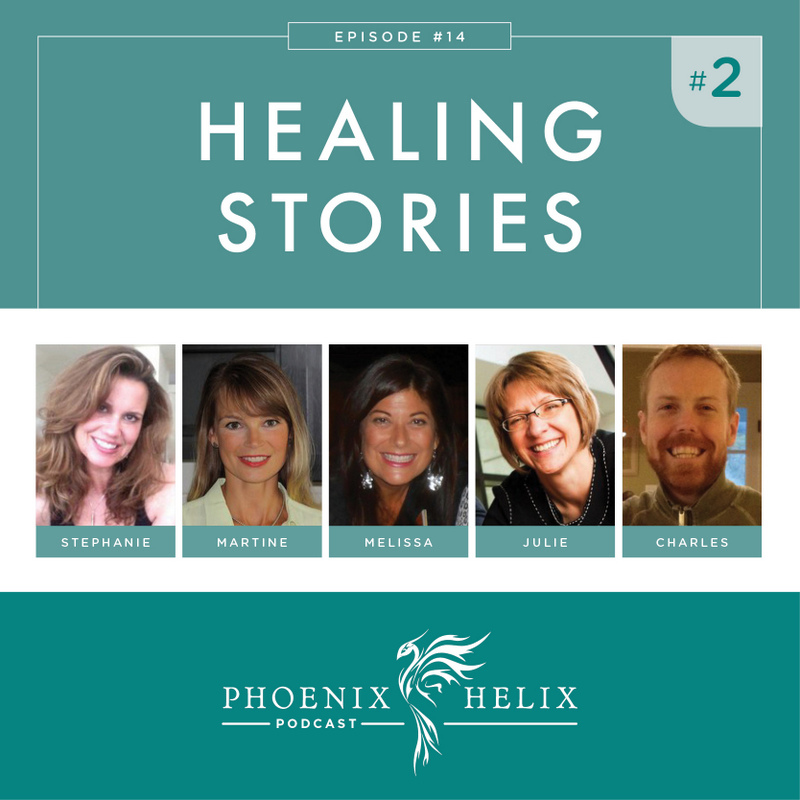
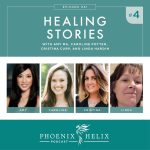
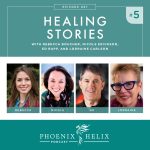
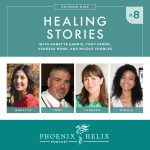


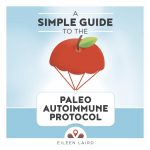

I did not eat sugar for ten days and it seemed like I flared up. Have you ever had a healing reaction when you got really strict with your diet? Or did you only feel better and better?
Hi Mimi. I continued to flare as I healed – the flares simply diminished in number and intensity over the course of a year’s time. It’s normal to flare at first, because it takes time for your immune system to calm down. It’s unlikely that giving up sugar caused your flare, unless you went too low-carb. If you gave up all fruits and starches along with all sugar, then that might have put too much stress on your body. We all need some of every macronutrient, including carbohydrates. if that isn’t the case for you, I would look at other triggers such as stress, sleep and emotions, which are often-overlooked.
Thank you for this! It is just what I need to keep me going with AIP. Also, I just read Charles’ article that you linked to above and it is very, very interesting–I highly recommend finding the time to read it. (Link reposted here) http://thepointmag.com/2012/examined-life/plea-human-food
I’m so glad, Susan! That’s why I do this podcast. 🙂
Eileen, I was reading the article she posted above, and am reminded about the fact that I too, have felt wonderful on days when I fasted (done because I was ill). I have followed AIP to the very T; have had food sensitivities tested for (whether they are accurate or not), and still my RA gets worse. Any advice for figuring out what foods are causing the problem, when you’re already following “The Gold Standard”? I also don’t eat starchy foods, I already know they are a problem. I guess I’m at a loss where to begin, in regards to the rest of the diet.
Hi Sarah. I’m sorry your RA is getting worse, because I know that’s both frustrating and scary when you’re trying so hard. At this point, I don’t recommend removing more foods. We need nourishment to heal, which is why fasting isn’t a long-term solution, and removing more and more foods isn’t either. Have you read my article Top 5 Mistakes People Make on the AIP? If not, check that out to see if any apply to you. If not, I recommend getting a 1:1 consult with either Katy Haldiman or The Paleo Mom Consulting, to help uncover whatever underlying issues are an obstacle to your healing. Wishing you well, and hoping you find answers soon!
Hi there, I have been following the AIP for several months and am definitely seeing improvements in my health. I have a question though. I just had a blood test run and there are some foods that are restricted on the AIP that the blood test says I am not having reactions to. Is it OK to reintroduce those foods ( tomatoes, walnuts, quinoa) without doing the slow introduction period? And also I am having moderate reactions to red beef so should I only make chicken bone broth?
Thanks!
Hi Willow. Unfortunately those types of blood tests aren’t accurate. They’re prone to both false positives and false negatives. I know that’s frustrating it you just spent a lot of money on them. The AIP is the “gold standard” for identifying food intolernces, and a careful reintroduction process is the only way to know if you do or don’t tolerate a food. It sounds like you’re ready to start reintroductions though, and you can start with those foods, if you like. Just be sure to reintroduce just one food at a time and follow all the steps. This article gives more details: http://autoimmune-paleo.com/why-food-intolerance-testing-doesnt-work/
I love your blog. Have you ever flared up the next day after taking too much vitamin c ? Or do you think it is cutting back on prednisone too quickly? I am trying to taper my prednisone and when I do every joint hurts . Usually I am dealing with 5 bad spots on my body with my RA but not head to toe. I am currently at 6.5 mg of pred, the highest I was taking regularly was 10-15mg. I have been at 6.5 for awhile, but I want to taper down even more, so I don’t get any bad side effects.
Hi Mimi. It’s much more likely to be the prednisone tapering. The prednisone’s role is to reduce inflammation in your body, so you can only reduce the dose if you are managing the inflammation in another way (like diet/lifestyle). I seem to remember in your first comment here that you sometimes eat foods you know you shouldn’t. Unfortunately, when it comes to using diet to reverse autoimmune disease, 100% commitment is really needed. Otherwise, we keep spiking our body with inflammatory foods and are less likely to be successful reducing medications. On the plus side, the fact that you once took 15 and are down to 6.5 is wonderful. Here’s an article that’s worth a read: The Top 5 Mistakes People Make on the Paleo AIP
You are right I should be 100% dedicated. I know I should not eat what can hurt me, but I find comfort in food, you would not know since I weigh 115 pounds. My weakness is sweet drinks, I will have to find some substitutes. Take care!
You’ll get there when you’re ready, Mimi. Be gentle with yourself. Sometimes it helps to come up with a list of other things that comfort you. Then, when you’re craving a sweet drink, you can look at the list and choose something else.
Hi Eileen, Thank you so much for these personal accounts of dealing with AI disorders. Listening to Healing Stories part 2, bumped me back to part 1, in which you covered your own journey with RA. I, too, have an RA diagnosis and so far have stood my ground in avoiding the immuno-suppressants. I did take a round of steroids to interrupt a ruthless flare last summer, and finally weaned myself off them about 5 months later. I hope never to return to Predisone. I have a specific question regarding your use of Alleve. You mentioned low doses in the morning and evening. Are you still at those levels? Could you let me know how many mg? I find the naproxen sodium to be really effective. I limit my intake to one 220mg about every fourth day. Did your doctor prescribe lower doses? It’s hard not to feel guilty about depending on this little blue pill. I’d like to take less, and wonder about the long term effects. Bless you and your generous nature. Sometimes I skip the recipe roundtables, but I’m thankful you’re in my email box as regularly as you are. Long live the Phoenix Helix.
Hi Jen. It’s a strange world when we are made to feel guilty for relieving our pain, isn’t it? I’ve written about this in detail in my article: When Painkillers Are Good For You. RA gives you a different perspective! It sounds like our stories are similar yet different, which makes sense since we are all unique. I’ve never had to take steroids, but I take more Aleve than you do at this point. 220mg is my “low dose” and it’s lower than any prescription, and far lower than what is typically prescribed for RA. The fact that you only need that every 4 days is impressive. If I try to go days between doses, my inflammation ramps up to an uncomfortable level. Disclaimer – I’m not a doctor – but the general recommendation with RA is to keep the inflammation low on a day-to-day basis, to avoid that ramping up. Are you taking any supplements? If not, they might be enough to replace your Aleve altogether. You can see which ones I take in this article: Where Supplements Fit on a Healing Diet. While diet/lifestyle made the biggest difference for me, supplements also had an impact on lowering my dose to this level (and avoiding the stronger meds as well). Lastly, you could ask your doctor if they could write you a low-dose Naproxen prescription (lower than Aleve) that could be filled at a compounding pharmacy. Compounding pharmacies fill non-traditional prescriptions. That would be more expensive than the Aleve, but if you have insurance, they might cover it. Thanks for reaching out, and for sharing your story.
Thank you for sharing these stories. My autoimmune issues are mild by comparison, but still not much fun. I have been gluten free for 8 years — which has helped immensely — but am now working up the courage to adopt the full AIP. Thank you for lighting the path and inspiring me.
Hi Joanne. Recording these episodes inspires me as well!
I cannot wait to listen. A friend sent this to me. God bless you!
That’s a good friend! I hope you enjoyed it.